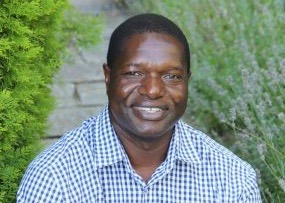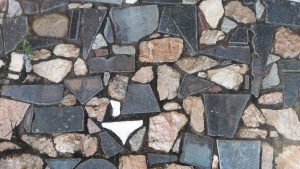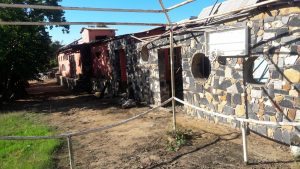
NER poet Vonani Bila talks with our office manager Elizabeth Sutton about South African life, languages (“It’s amazing that South Africa has eleven official languages, but English and Afrikaans are more official than others!”), and the legacy of John Mehlwana Baloyi.
ES: In your poem “Baloyi’s art gallery” you reconstruct the bricks, weeds, mirrors, cow dung, and corrugated iron so wonderfully that we can see the gallery clearly and then mourn its loss. Can you tell us about Baloyi and why you chose to write about the gallery?
VB: These images and fragments of building scraps represent an adventurous, ecstatic, and strong-willed John Mehlwana Baloyi (1964–2006), who was a lively people’s person and a crafty, multi-dimensional artist concerned with the ideas of an imaginary home and dislocation, the visible and the invisible, the controlled and uncontrolled as defining components of the creative process or composition, and as tools with which to interpret his social reality and nonsense/madness. I’m sure Baloyi’s playful spirit had something to do with his choice and use of derelict—but intriguing—materials.

In the same vein, these materials were probably a joy for him to collect, and perhaps he relished that the gallery—his utopia—would be strong, eye-catching, exotic, memorable, and reliable, and not crumble and dissolve when the torrential rains poured over its roof.
I wrote this portrait poem as dedication to John Baloyi, noting that he was the first rural black artist I know from Limpopo province to initiate a rurally-based art gallery without depending on the government. Even today, the Limpopo government doesn’t have a functional public art gallery, twenty-four years into freedom. Today, Baloyi’s gallery is in a sorry state, in shambles, with no curator or government support. Most of the wooden sculptures are being burrowed by ants and destroyed by the rains. No one is making noise to rescue the legacy of one of South Africa’s talented artists. In spite of his immense contribution to the art world, Baloyi remains a peripheral and marginal figure in the eyes of the ANC-led government. It’s so sad when the shadow that reflects black excellence is deliberately vanquished and grounded by those who are expected to elevate it.
What is sad is that John Baloyi’s legacy is slowly disappearing: the school system hardly studies his work in their syllabi, and the two local universities in Limpopo neither offer fine arts nor have any art museum to preserve the artistic excellence in the works of local sculptors such as Baloyi himself, Noria Mabasa, Phillip Rikhotso, Hendrik Nekhofhe, Nelson Makhuba, or Jackson Hlungwani.
ES: You have dedicated the poem to the activist and Judge Albie Sachs. Was he part of the inspiration of this poem?

VB: Yes, the poem was really inspired by Albie Sachs (Albert Louis Sachs, b. 1935), former Constitutional Court judge. It calls upon the wisdom of this humble yet gigantic cultural and human rights icon to impress on the newly established black government to recognize and honour their own talented artists. Sachs travelled over six hours from Johannesburg to attend the opening of Baloyi’s art gallery at Zamazama near Elim. He didn’t expect any payment or media coverage. When he was given an opportunity to speak about Baloyi’s art, he was eerie, and spoke with the infectious smile of someone consumed by the beauty of art and humanity. I hold Sachs in high esteem for his commitment to social justice, including his efforts to make African art visible in public spaces. It is Sachs, in his influential position as Constitutional Court judge, who introduced John Baloyi’s ground-breaking three-metre-long sculpture called Godzilla to the urban folk when he included it in his art collection for the revered Constitutional Court in Johannesburg.
ES: You are the founder of the Timbila Writers’ Village in Limpopo Province. Can you describe who attends and how it works?
VB: The Timbila Writers’ Village was established in 2010 as a meeting point and workplace for authors, translators, publishers, cultural activists, and researchers from South Africa, Africa, and abroad. It’s a special retreat designed to be relaxed and friendly. Its invigorating environment will stimulate authors at all stages of their writing practice and experience. Writing fellowships are offered in all categories of imaginative writing—poetry, fiction, creative nonfiction, children’s books, illustrating, script writing, and translation, as well as social research.
Committed South African and non-South African authors who are proficient in English and/or any official South African language, and working on a major project, may apply for professional residency programmes from one week to a maximum of two months. The village can accommodate up to five writers at a time, each allocated a fully-furnished room with a writing space and bathroom. Writers are expected to give a seminar and/or reading on what they are working on to other guest writers, enthusiasts, and local readers. The seminar provides a platform for others to critically engage with the writer’s work-in-progress.
ES: Aside from the South African writers who appear in NER Vol. 38.4, are there other poets, perhaps some who have appeared in your own Timbila Poetry Journal, who you think people should be reading?
VB: First I’m delighted that my poem was published in NER alongside my fellow South African profound poets and writers that I hold in high regard. They are solid wordsmiths who have made a huge mark on the landscape of South African poetry. Poets that stand out for me are especially those who continue to write effortlessly in indigenous languages and English, such as lyricist Sandile Ngidi whose debut collection Friends of the Tender Board will be released this year; David wa Maahlamela whose performative poetry flourishes on rare images, lyricism and parallelism, and idiophones. In Xitsonga, I am attracted to the sensitive political poems of Moses Khaizen Mtileni, as well as Max Marhanele’s obsession with language.
Some of the poets I’ve published in Timbila are experimental both with language and form, and handle big political issues with ease—with a refreshing language that shines through with intelligent satire.
A lot still needs to be done to make South African poetry known and respected. A translation program should be embarked upon. More creative writing programs are required to introduce writers to other ways of looking at writing. More literary magazines are needed to serve as germinating ground for new poets. Surely a country of more than 55 million shouldn’t be served by fewer than ten literary magazines. Good local poets must be studied in schools alongside Shakespeare, Keats, W. B. Yeats, Constantine Cavafy, Joseph Brodsky, Amiri Baraka, June Jordan, Allen Ginsberg, Czeslaw Milosz, Robert Desnos, Emily Dickinson, Blake, W. H. Auden, and Wordsworth.
ES: South Africa has eleven official languages. Do you write or speak any languages other than English?
VB: It’s amazing that South Africa has eleven official languages, but English and Afrikaans are more official than others! I’m proud that I write in Xitsonga, Northern Sotho, plus English. I’m able to communicate with less difficulty in Tshivenda, IsiZulu, Setswana, Sesotho, and IsiXhosa, and I did Afrikaans at high school.
I write in Xitsonga because it’s my mother tongue and home language, and a language of my forefathers. There are certain messages that best find expression and a sound register in this language. I dream in Xitsonga, even when I’ve visited Europe. It’s an old language, perhaps over 400 years old, which is spoken in South Africa, Mozambique, Zimbabwe, and some parts of Swaziland. In South Africa it is regarded as a minority language, despite that over fifteen million people speak and sing in this language.
My passion to preserve indigenous languages prompted fellow poet and grammarian Max Marhanele and me to work on a monolingual Xitsonga dictionary. This ground-breaking project took us twelve years to complete, despite the meager funding at our disposal. We are certain that one day that Xitsonga will, like the big languages of the world, find its seat in the hall of living languages. We believe Xitsonga will survive the glaring onslaught and extinction that most uncared for African languages are facing, even more so because a lot of these languages don’t have basic texts like dictionaries. Marhanele and I are not deterred by the fact that there are fewer than 1,000 books in Xitsonga, and that our language (which has produced some of the best composers like D. C. Marivate, S. J. Hlekani, and wonderful poets like B. J. Masebenza, Winston Nkondo, and James Magaisa, among others) is maligned by the mainstream media.
I write in Xitsonga to challenge the silent and negative patterns of English and Afrikaans hegemony. In doing so, I hope my works are capable of establishing an interactive dialogue with the reader and his community.
It is sad that the marginalization of African languages in South Africa happens despite the rhetoric that we have eleven official languages. The truth is the Animal Farm reality where English and Afrikaans are bully boy languages looking down upon nine indigenous South African languages. The choice/act of undermining African languages is this time being carried out by the ANC-led government because it continues to believe that English is the glue that will unite South Africans, meaning that English as a monopolistic lingua franca becomes a truly official language in spite of its being used effectively by a mere 10 percent of the populace.
My country, South Africa, has an active liberal population that campaigns for service delivery and anything towards radical social justice. People march for clean water, reliable electricity, AIDS treatment, housing, jobs; civil, political, and economic rights, etc., but they seldom march to protect their languages and cultural rights. Culture is regarded as a soft issue. In a country with over 28,000 schools, it is sad that most of these schools do not have functional libraries. My village, Elim/Shirley, the place with rich liberation history and with a population of more than 80,000, still doesn’t have a library.
Now our freedom, our languages, our culture, and national identity are under siege. Our politicians seldom communicate in mother tongue. Universities have fewer resources dedicated to the development of African languages. The government urges everyone to do mathematics and science as if these are the end-all panacea to South Africa’s ills. So when one writes in Xitsonga and any of the indigenous languages, you know that you will be treated as trash, an odd writer who is fighting a losing battle because English is an unstoppable wave that will swallow all the small languages of the world. That’s very wrong!
“Baolyi’s art gallery” appears in NER 38.4
order a copy of NER today — or better yet, subscribe!